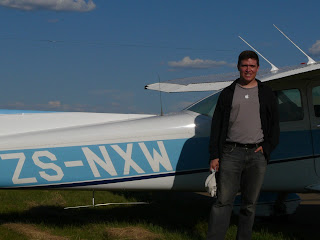So, while I fly downwind looking in vain for the lodge, another aircraft announces its intention to land here. I inform it of my position and chosen runway, and soon land. The other plane is so close that I don't backtrack on the runway all the way to the parking area, but wait in the middle at the wind sock, and soon enough the other pilot lands (here approaching above a parked aircraft):

Fortunately the other plane has arranged for a pickup and overflown the lodge on the other side, so we are soon picked up. The other pilot, Rachel, is a commercial pilot for Desert Air, and has 5 passengers, French tourists. We have lunch together.

Note the beautiful sunglasses that I have bought in Keetmanshoop for about 2 EUR.


And we drive back to the airfield.

Preflight.

Takeoff from FYKC (Canyon Lodge at Fish River Canyon, Namibia).

Fish River Canyon from about 3500ft MSL or 1000ft AGL.


In case of engine failure, land here:


Back in FYKT (Keetmanshoop), I have the fuel tanks filled up, and quickly go inside the airport building for a weather update for my next flight to Olifantwater. Within minutes, a thunderstorm builds up, heavy rain starts, and I run to secure the plane (control locks, chocks). Totally soaked I wait, and wait. At 17h, the airport closes, and the very friendly lady from the fuel station (she's been running this business for 44 years) offers me a ride to town - I am not leaving today. A beautiful evening compensates. And, here in Keetmanshoop I eat the best steak I have ever eaten. Fantastic food, both at the Schützenhaus and the Central Lodge.





















.jpg)





.jpg)





